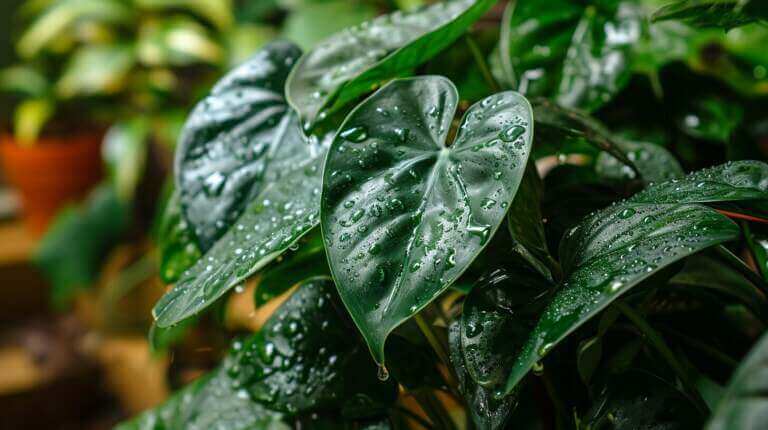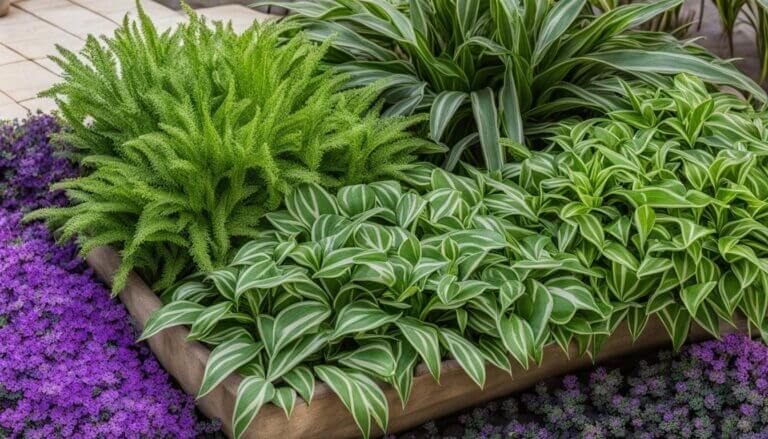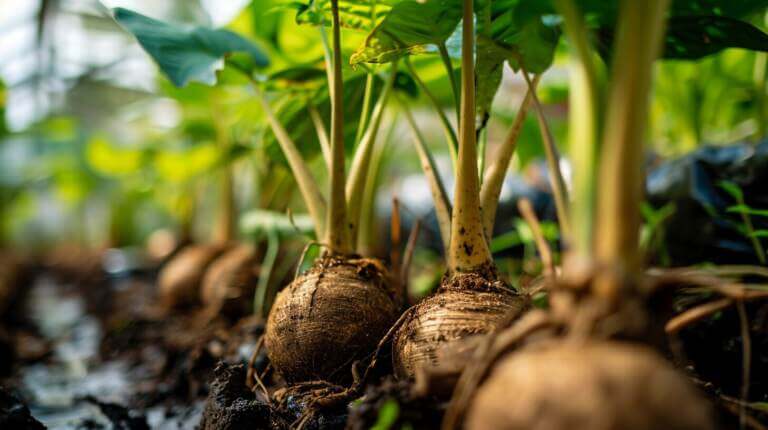A Beginner’s Guide to Grow and Care For Polka Dot Plant (Hypoestes Phyllostachya) Indoors
The polka dot plant, also known as Hypoestes phyllostachya, is a popular indoors houseplant loved for its variegated leaves that are adorned with polka dot patterns. With their vibrant colors, these plants can instantly brighten up any room and add a touch of nature to your indoor space.
Growing polka dot plants is relatively easy, and with the right care, you can enjoy these beauties for years to come. From providing the perfect lighting and watering conditions to propagating new plants and dealing with common pests, I will guide you through every step of the way.
Key Takeaways:
- Polka dot plants, also known as Hypoestes phyllostachya, are popular houseplants with variegated leaves.
- They add vibrant colors and a touch of nature to indoor spaces.
- Polka dot plants are relatively easy to care for and can thrive with the right lighting, watering, and maintenance.
- Propagation can be done through stem cuttings, allowing you to expand your collection.
- Regular inspection and pest control measures are important to prevent common pests and diseases.
About the Polka Dot Plant
The polka dot plant, scientifically known as Hypoestes phyllostachya, is a popular houseplant valued for its beautifully variegated foliage. This herbaceous warm-climate perennial is commonly grown as a houseplant due to its moderate growth rate and easy care requirements. With its vibrant polka dot patterns in various colors such as pink, red, purple, and white, the polka dot plant adds a touch of color and personality to any indoor plant collection.
As a houseplant, the polka dot plant, also known as Begonia maculata, is highly adaptable and can thrive in different environments. Its easy care nature makes it suitable for beginners and experienced plant enthusiasts alike. Whether you’re looking to brighten up your living space or create an indoor jungle, the polka dot plant is an excellent choice.
Foliage
The main attraction of the polka dot plant is its foliage. The leaves are adorned with polka dot patterns, with each leaf exhibiting a unique combination of colors. The contrast between the vibrant dots and the lush green background creates a visually striking appearance. The polka dot plant’s foliage adds texture and dimension to any indoor plant display, making it a standout feature in any room.
Polka Dot Plant Care – Light and Temperature Requirements
Proper lighting and temperature are essential for the health and growth of polka dot plants. Understanding their specific needs can help you create an optimal indoor environment for these beautiful houseplants.
Light Requirements
Polka dot plants thrive in bright, indirect light. They love to bask in the gentle rays of the sun but should be protected from direct sunlight, as it can scorch their delicate leaves. Place them near a window that receives bright, filtered light or use sheer curtains to diffuse the sunlight. If the lighting in your home is insufficient, consider supplementing with artificial grow lights to provide the necessary light spectrum.
Temperature Requirements
Polka dot plants prefer warm temperatures ranging from 65 to 75 degrees Fahrenheit (18 to 24 degrees Celsius). They are well-suited for indoor environments where the temperature remains relatively stable. Avoid exposing them to cold drafts or sudden temperature fluctuations, as it can stress the plants and affect their growth. Remember, maintaining a consistent temperature and providing adequate lighting are key to keeping your polka dot plant healthy and thriving.
| Light Requirements | Temperature Requirements |
|---|---|
| Bright, indirect light | 65-75°F (18-24°C) |
| Avoid direct sunlight | Keep away from cold drafts |
| Consider using grow lights | Avoid sudden temperature fluctuations |
Hypoestes Phyllostachya – Watering and Humidity Tips
Proper watering and humidity levels are essential for the health and vitality of your polka dot plants. Let’s explore some tips to help you care for your plants effectively.
Watering Polka Dot Plants
When it comes to watering your polka dot plants, it’s important to strike a balance. These plants prefer consistently moist soil, but overwatering can lead to root rot. To avoid this, check the moisture levels of the soil regularly and water when the top inch or two has dried out.
Avoid allowing the soil to become completely dry, as this can cause stress and damage to your plants. On the other hand, be cautious not to overwater, as it can drown the roots and lead to fungal issues. Finding the right watering schedule can vary depending on factors such as the size of the pot, the temperature, and humidity levels in your home.
Humidity Requirements
Polka dot plants appreciate high humidity levels, so it’s important to create a suitable environment for them. One way to increase humidity is by using a humidifier in the same room as your plants. This can help mimic their natural tropical habitat and keep their leaves healthy and vibrant.
If you don’t have a humidifier, you can also mist the leaves of your polka dot plants regularly. Fill a spray bottle with water and mist the foliage in the morning or evening. Avoid misting too close to bedtime, as excess moisture on the foliage overnight can promote fungal growth. This simple step can provide a boost of humidity and improve the overall well-being of your plants.
Polka Dot Plant Propagation Techniques
Propagating polka dot plants is an exciting way to expand your collection and share the beauty of these vibrant houseplants with others. One of the most common methods of propagation is through stem cuttings. This simple technique allows you to create new plants from a healthy parent plant.
Taking Stem Cuttings
To propagate polka dot plants through stem cuttings, start by choosing a healthy and well-established parent plant. Using clean and sharp gardening shears or scissors, cut a 4-6 inch stem just below a set of leaves. Remove any lower leaves from the stem, leaving only a few sets of leaves at the top.
Rooting the Cuttings
Once you have your stem cuttings, you can root them in either water or moist soil. If using water, place the cuttings in a glass or jar filled with clean water, ensuring that the cut ends are submerged. Change the water every few days to prevent stagnation and promote healthy root development.
If rooting in soil, prepare a small pot with well-draining potting mix. Create a small hole in the soil with your finger or a pencil and gently place the cutting into the hole. Firm the soil around the base of the cutting to ensure good contact.
Providing Optimal Conditions
Regardless of whether you choose to root your cuttings in water or soil, it’s important to provide them with warm, indirect light. Place the cuttings in a bright location away from direct sunlight, as this can cause leaf burn. Maintain a consistent level of moisture, ensuring that the soil or water remains slightly damp but not soggy.
Transplanting the New Plants
After a few weeks, you should start to see roots develop on your polka dot plant cuttings. Once the roots are well-established, you can transplant the new plants into their own individual pots. Use a well-draining potting mix and provide the same care as mature polka dot plants.
Propagation through stem cuttings is a rewarding and effective way to create new polka dot plants. With a little patience and care, you can expand your collection and share the joy of growing these beautiful houseplants with others.
Polka Dot Plant Indoors – Common Pests and Diseases
When it comes to polka dot plant care, it’s important to be aware of the common pests and diseases that can affect these vibrant houseplants. By being proactive and implementing effective pest control measures, you can keep your polka dot plants healthy and thriving.
Common Pests
Polka dot plants are susceptible to various pests, including aphids, mealybugs, and spider mites. These pests can cause damage to the leaves and affect the overall health of the plant. Regularly inspect your plants for signs of infestation, such as sticky residue, webbing, or distorted leaves. If you notice any pests, do not panic; there are several pest control methods you can use to combat them.
Aphids, mealybugs, and spider mites are common pests that can be controlled with insecticidal soap or neem oil. These natural remedies can effectively eliminate the pests without harming the plant. Be sure to follow the instructions on the product label and treat the plant accordingly.
Plant Diseases
In addition to pests, polka dot plants can also be susceptible to certain diseases, including root rot and powdery mildew. Root rot is caused by overwatering and poorly drained soil, while powdery mildew is a fungal disease that thrives in humid conditions. To prevent these issues, it’s important to maintain proper watering practices and provide adequate airflow around the plant.
If you suspect root rot, carefully remove the plant from its pot and inspect the roots. Trim away any mushy or darkened roots and repot the plant in fresh, well-draining soil. To prevent powdery mildew, ensure proper air circulation by providing space between plants and avoid overhead watering. If powdery mildew does occur, you can treat it with a fungicide specifically formulated for this disease.
By being vigilant and taking the necessary steps to control pests and prevent diseases, you can ensure that your polka dot plants remain healthy and vibrant. Regularly inspect your plants, provide them with the right care, and address any issues promptly to maintain the beauty of these stunning houseplants.
Repotting Your Polka Dot Plant and Maintenance
Repotting your polka dot plants is an essential part of their care routine to ensure they continue to thrive. As these plants grow, they may outgrow their current pots, leading to limited root space and restricted growth. Repotting allows for the expansion of the root system and provides the plant with fresh, nutrient-rich soil.
To repot your polka dot plant, start by choosing a container that is slightly larger than its current one and has drainage holes at the bottom. Gently remove the plant from its old pot, being careful not to damage the roots. Place a layer of fresh potting soil at the bottom of the new pot, ensuring it is evenly distributed. Then, carefully place the polka dot plant in the center of the pot and fill in the remaining space with more soil, gently pressing it down to secure the plant.
After repotting, it’s important to provide proper maintenance for your polka dot plants. Regularly prune back any leggy growth to encourage bushier growth and maintain the desired shape of the plant. This can be done by cutting back stems just above a leaf node or pair of leaves. Additionally, monitor the plant for any signs of nutrient deficiencies, such as yellowing leaves or stunted growth, and provide appropriate fertilization to address these issues.
Polka Dot Plant Maintenance Tips:
- Place your polka dot plant in a location with bright, indirect light to ensure proper growth.
- Water the plant when the top inch or two of soil has dried out, and ensure good drainage to prevent root rot.
- Maintain a humidity level of around 50-60% to mimic the plant’s native tropical environment.
- Keep an eye out for common pests like aphids and spider mites, and take prompt action to control them if necessary.
FAQ
How often should I water my polka dot plant?
Keep the soil consistently moist, but avoid overwatering. Check the moisture levels of the soil regularly and water when the top inch or two has dried out.
Where should I place my polka dot plant?
Polka dot plants thrive in bright, indirect light. Place them near a window where they can receive plenty of natural light, but avoid direct sunlight.
How do I propagate a polka dot plant?
You can propagate polka dot plants through stem cuttings. Take a cutting from a healthy plant, remove the lower leaves, and place it in water or moist soil. After a few weeks, roots will develop, and you can transplant the cutting into a new pot.
What pests should I watch out for on my polka dot plant?
Common pests that may infest polka dot plants include aphids, mealybugs, and spider mites. Regularly inspect your plants for any signs of infestation and take appropriate measures to control the pests.
How often should I repot my polka dot plant?
Over time, your polka dot plant may outgrow its pot and require repotting. Monitor the plant’s growth and repot it when it becomes too crowded. Choose a container with good drainage and transfer the plant into fresh, well-draining potting soil.







